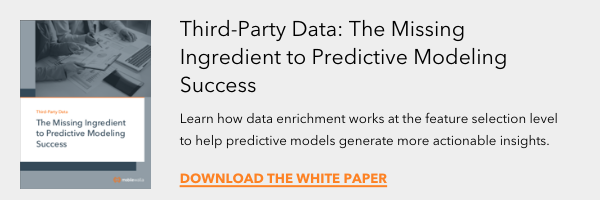Predictive analytics is the use of data, algorithms, and machine learning to forecast outcomes. Also known as predictive modeling, it underpins nearly all machine learning and artificial intelligence processes. While this field of study has been around for decades, the current data explosion coupled with modern computing power brings predictive analytics to the forefront of many business operations.
Predictive models can help identify fraud, improve inventory and pricing operations, reduce risk, optimize marketing campaigns, and more. The artificial intelligence software market generated about $15 billion in worldwide revenue in 2019. By 2025, that number is expected to reach $119 billion.1
Before you go all in on artificial intelligence, it’s important to understand the foundations of successful predictive models. No matter which algorithm or software you utilize, you need enough data to fuel it. Data enrichment is the key to getting the most out of your predictive modeling investment.
Elements of A Predictive Model
Predictive models are used to reach a conclusion about how likely a subject (typically a customer or prospect) is to perform a desired action (such as making a purchase).
When leveraged in marketing, one of the main goals of predictive modeling is to identify the “states” (which may include demographic information, purchase history, or any other behavior) that are most likely to reach or influence the target outcome, so that people who share these states can be targeted with relevant campaigns.
Here’s an example: If a predictive modeling exercise shows that individuals who visit high-end malls and frequently travel by air are more likely to purchase luxury smartphones, then a phone provider looking to grow their customer base knows that targeting high-end shoppers and frequent flyers with their marketing campaigns will likely result in higher ROI.
The individual predictive states of the model are also known as features. In this case, the states/features are high-end mall visits and frequent air travel.
Where Do Predictive Models Go Wrong?
Insufficient Data
In data science, there’s a general belief that algorithm sophistication is the single most important factor in predictive modeling success. In reality, the breadth and depth of data used to train the algorithm has a bigger impact on improving predictive quality over time.
If your approach is thorough and your methods are by the book, yet you still can’t achieve the predictive quality you need, then limited data is likely the source of your problem.
Feature Selection
Feature selection – the identification of which features to use for modeling – is a pivotal task. When building a predictive model, data scientists must evaluate and refine each feature until an actionable high-probability model is reached.
In order to be actionable, the final version of a predictive model must include features that are easily projected onto the larger population. Teams working exclusively with first-party data often generate insights that can’t be applied to the general public.
The feature selection process is often where predictive models go wrong and insufficient data is the leading cause of suboptimal feature selection. After all, you can only conduct statistical analysis on the data that’s available to you. A limited scope of data cripples your model’s ability to project probability statements onto the population at large.
Better Data = Higher Value Predictive Models
To effectively identify and market to new prospects, and to better understand, retain, and grow an existing customer base, you will need to build your predictive models using data that reaches far beyond what you have in-house.
No matter how sophisticated your algorithms are, if you are leveraging only first-party data to inform your predictive models, they’ll be limited to generating insights based on your current customers. They won’t provide a comprehensive look at all of the states that might be relevant to your desired outcome, and the features that are available may not apply to consumers who are not customers.
The Solution to Limited Data
When a global food delivery company found themselves in the situation we just described, they turned to Mobilewalla for additional consumer insights.
The company’s first-party data revealed that its highest-value customers ordered Chinese food three times a week, after 8 PM. However, they couldn’t use these insights to grow their customer base because there was no way for them to identify non-customers who fit that description. That means they couldn’t target this group with their campaigns.
The solution to this problem was data enrichment. Mobilewalla bolstered their first-party data with comprehensive third-party data giving them a more detailed picture of current customer habits and behaviors. Subsequent analysis revealed the following about their highest-value customers:
- Likely to be married, with both spouses working
- Aged 25-34
- Have children
- Have a home-to-work commute greater than 15 km.
This information empowered the food delivery company to target audiences likely to become high-value customers much more precisely and effectively.
To read more about the insights they uncovered, download the case study. To learn how you can supercharge your predictive models through data enrichment, download the white paper.
Ready to learn more about how data enrichment can work for your brand? Contact a Mobilewalla expert to discuss your challenges and take a data-driven leap into growing your ROI.

Mobilewalla
Start making more informed business decisions and effectively acquire, understand, and retain your most valuable customers. Get in touch with a data expert today

